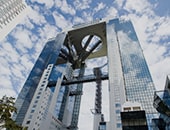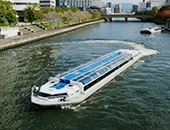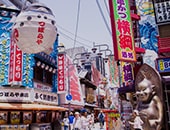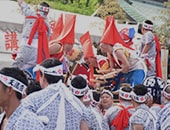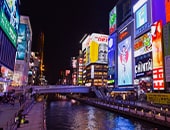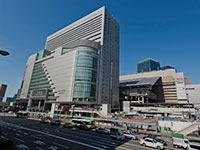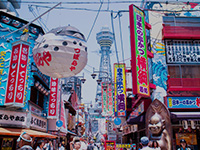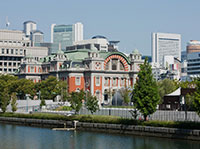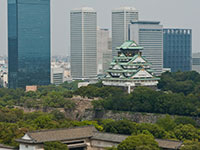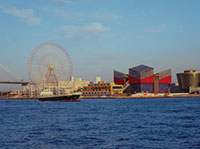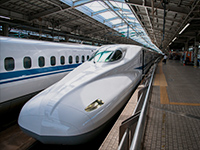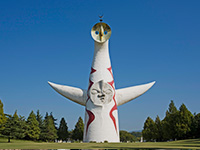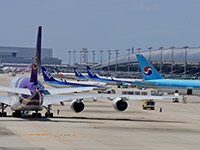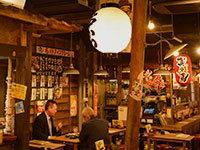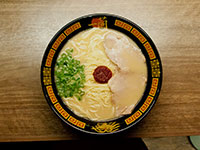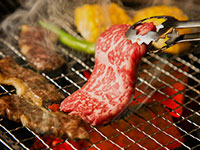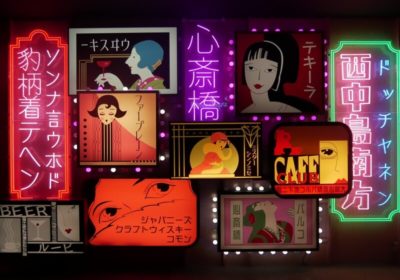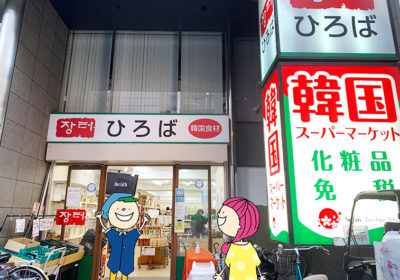

Osaka Bob FAMILY
How Do You Get Between Osaka and Kyoto? Your Best Route Depends on Where You’re Going in Kyoto!
Hi! I’m Natiyda and I’m from Thailand.
I came to Japan because I love the energy in Osaka. And while Osaka will always be my first choice, there are lots of other wonderful cities in the Kansai region to visit outside of Osaka. In particular, neighboring Kyoto is one of my favorite places to go because of its rich culture and sophisticated charms.
But did you know, there are actually three train lines connecting Osaka and Kyoto? A lot of people aren’t sure which route to take, so I want to give you all some advice. I used to be unsure of how to get back and forth myself, so let me explain how I decide which train line to use. Choosing the right train based on your destination will save you a lot of time and headache!
[Contents]
- Introducing the three railways that connect Osaka and Kyoto—JR, Hankyu, and Keihan
- Major tourist destinations near the JR, Hankyu, and Keihan stations
- Hankyu and Keihan are the best way to get to Kyoto’s most popular downtown areas—Kawaramachi and Gion!
- Keihan is convenient to get to Higashiyama. So is Hankyu!
- Take the Hankyu from Osaka to Arashiyama. It’s cheaper than JR!
- Keihan is a great way to get to Uji. But JR works too!
Introducing the three railways that connect Osaka and Kyoto—JR, Hankyu, and Keihan
First things first, there are three different rail companies that connect Osaka and Kyoto: JR, Hankyu Railway, and Keihan Electric Railway. Understanding the different features of each train line, can help you plan your trip!
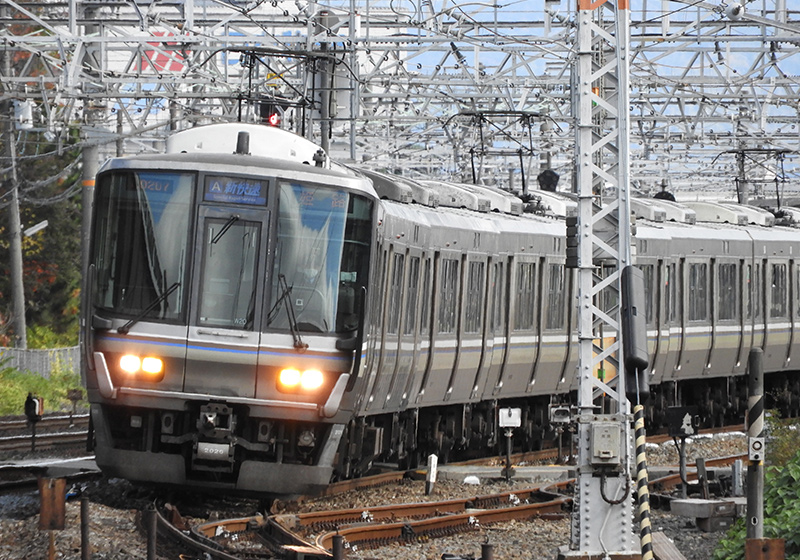
JR is the largest railway in Japan.It also operates the Shinkansen, which does run between Osaka and Kyoto. But it requires an express fare in addition to the regular ticket and is not very practical for most people going between Osaka and Kyoto, so I won’t be going into the Shinkansen in this article.

Hankyu Railway has a classy image and has traditionally used this signature maroon color for its trains. Hankyu connects Osaka to Kyoto, Takarazuka, and Kobe. Hankyu also operates the Arashiyama Line, which can take you to the very popular tourist destination Arashiyama, in Kyoto.
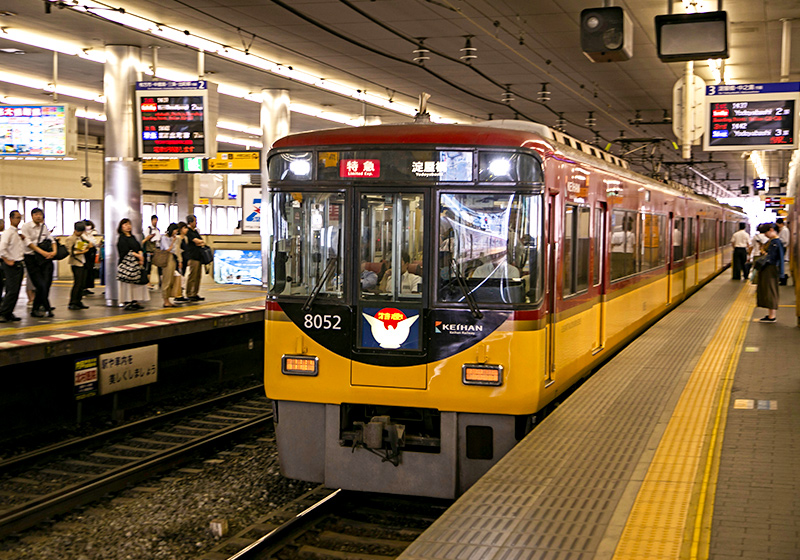
The Keihan Electric Railway is a railway company at the forefront of many trends, like playing departure melodies and running express trains. They were the first railway to do so in Japan. In the Kansai region, the company is famous for its catchy advertising campaigns.
Comparing the duration, fare, and major stations of JR, Hankyu, and Keihan trains
So, if you’re going from Osaka to Kyoto, which of the three should you take: JR, Hankyu, or Keihan? First, let’s take a look at the ride duration and fares.
| Stations | Duration | Train fare |
|---|---|---|
| JR (Osaka Station–Kyoto Station) |
29 min. | ¥580 |
| Hankyu Railway (Osaka-Umeda Station–Kyoto Kawaramachi Station) |
43 min. | ¥410 |
| Keihan Electric Railway (Yodoyabashi Station–Gion Shijo Station) |
47 min. | ¥430 |
*The times listed are approximate and indicate the ride times for the JR special rapid service, and limited express for the Hankyu and Keihan.
If your biggest concern is time, JR is the clear winner. But in terms of price, it’s Hankyu hands down.
- If you’re in a hurry, you should take the JR.
- If you want to save money, take the Hankyu
But, you see that’s not necessarily the case…
Think about where you want to go in Kyoto you and consider what the closest station is!
Of course, almost the whole city of Kyoto is like a tourist attraction. But keep in mind, it is not a compact city where you can easily walk from one destination to another. So it’s a good idea to start thinking, “Which train station is the closest to the tourist attraction where I want to go?”, when planning your trip. This will make your travels more efficient and smoother.
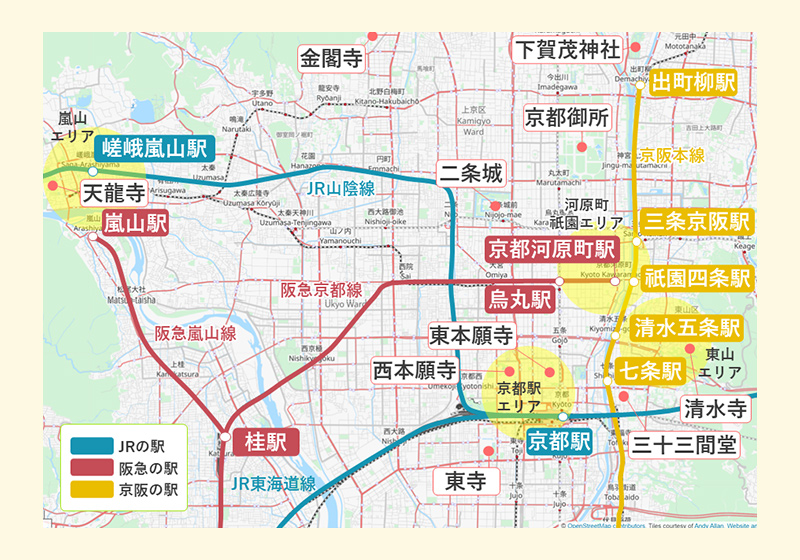
If you look at the map, you’ll see that both Hankyu (Kyoto-Kawaramachi Station) and Keihan (Gion-Shijo Station) stop in the popular Kawaramachi/Gion area of Kyoto. But there are no JR stations nearby.
Of course, you can still use the JR to get there. You could take the Kyoto Municipal Subway from JR Kyoto Station and then transfer to the Hankyu line at Karasuma Station. But that would be annoying because of all the transfers, right?
Another option would be to take a bus or taxi from JR Kyoto Station, but Kyoto is currently experiencing unprecedented levels of tourism so I wouldn’t recommend that option.

The buses are incredibly crowded. Congestion levels fluctuate depending on the time of day and the line. But I’ve heard stories from locals who can’t get on the bus because there are so many tourists.
So really, the smart way to get from Osaka to Kyoto is to choose your route, depending on where you are going in Kyoto. Then you can take a train line that will take you to the nearest station!
Major tourist destinations near the JR, Hankyu, and Keihan stations
Here I’ve put together a list of major tourist spots that are near each of the JR, Hankyu, and Keihan lines.
[Tourist spots along the JR lines]
In addition to the JR Kyoto Line, connecting Osaka and Kyoto, JR also operates the Sagano Line, which will take you to Arashiyama. And the JR Nara Line connects Kyoto and Nara. Note that you will need to change trains at Kyoto Station in order to use either the Sagano Line and Nara Line.
Kyoto Station
- Kyoto Tower https://www.kyoto-tower.jp/en/
- Higashi Honganji Temple http://english.higashihonganji.or.jp/english_top/
- Shosei-en Garden http://english.higashihonganji.or.jp/tour/shosei-en/
- Nishi Honganji Temple https://www.hongwanji.kyoto/en/
- Toji temple https://toji.or.jp/en/index.html
Umekoji-Kyotonishi Station (JR Sagano Line)
- Kyoto Aquarium https://www.kyoto-aquarium.com/en/index.html
- Kyoto Railway Museum https://www.kyotorailwaymuseum.jp/en/
Uzumasa Station (JR Sagano Line)
- Toei Kyoto Studio Park https://global.toei-eigamura.com
Saga-Arashiyama Station (JR Sagano Line)
- Tenryuji Temple https://www.tenryuji.com/en/
- Daikakuji Temple https://www.daikakuji.or.jp/english/
- Togetsukyo Bridge
Tofukuji Station (JR Nara Line)
- Tofukuji Temple https://tofukuji.jp/
- Mitera Sennyuji Temple https://mitera.org/
Inari Station (JR Nara Line)
- Fushimi Inari Taisha Shrine https://inari.jp/en/
Uji Station (JR Nara Line)
- Byodoin Temple https://www.byodoin.or.jp/en/
- Ujigami Shrine https://www.ujikamijinja.jp/
- Uji River
[Tourist spots along the Hankyu lines]
Hankyu Railway can take you all the way to Shijo Kawaramachi, Kyoto’s main shopping district. Or it can take you up to Arashiyama when you transfer at Katsura Station. And although Keihan Railway will drop you off a little closer, you can still get to the stunning Kiyomizu-dera on Hankyu if you walk from Kyoto-kawaramachi Station.
Kyoto-kawaramachi Station
- Pontocho
- Gion (Hanamikoji, etc.)
- Kamo River
- Nishiki Market
- Yasaka-jinja Shrine https://www.yasaka-jinja.or.jp/en/
- Chion-in Temple https://www.chion-in.or.jp/en/
- Maruyama Park
Arashiyama Station (Hankyu Arashiyama Line)
- Tenryu-ji Temple https://www.tenryuji.com/en/
- Daikaku-ji Temple https://www.daikakuji.or.jp/
- Togetsukyo Bridge
[Tourist spots along the Keihan lines]
Keihan Railway, which runs through Higashiyama (an area concentrated with temples and shrines) and Gion (Kyoto’s entertainment district), is probably the line that has access to the most tourist destinations. You can also take the Keihan to get to Uji, by transferring at Chushojima Station. You’ll also want to note that the closest station to Kiyomizu-dera Temple is Keihan’s Kiyomizu-gojo Station. But we recommend taking a stroll from Gion-shijo Station to get there because there is so much to see along the way.
Demachiyanagi Station
- Shimogamo Shrine https://www.shimogamo-jinja.or.jp/english
Jingu-Marutamachi Station
- Kyoto Imperial Palace https://fng.or.jp/kyoto/en/
- Heian-jingu Shrine https://www.heianjingu.or.jp/language/english.html
Gion-shijo Station
- Kamo River
- Gion (Hanamikoji, etc.)
- Yasaka Shrine https://www.yasaka-jinja.or.jp/en/
- Chion-in Temple https://www.chion-in.or.jp/en/
- Maruyama Park
- Kenninji Temple https://www.kenninji.jp/
- Kodaiji Temple https://www.kodaiji.com/e_index.html
- Ninenzaka and Sannenzaka
Kiyomizu-gojo Station
- Rokuharamitsu-ji Temple https://rokuhara.or.jp/
- Kiyomizu-dera Temple https://www.kiyomizudera.or.jp/en/
Shichijo Station
- Sanjusangendo Temple https://www.sanjusangendo.jp/ など
Tofukuji Station
- Tofukuji Temple https://tofukuji.jp/
- Mitera Sennyuji Temple https://mitera.org/
Fushimi-inari Station
- Fushimi Inari Taisha Shrine https://inari.jp/
Uji Station (Keihan Uji Line)
- Byodoin Temple https://www.byodoin.or.jp/en/
- Ujigami Shrine https://www.ujikamijinja.jp/
- Uji River
Looking at it all like this, you can see that Kyoto really has a lot of famous places!
Next, I’ll introduce the areas that are served by multiple train lines, and which trains are recommended to get there!
Hankyu and Keihan are the best way to get to Kyoto’s most popular downtown areas—Kawaramachi and Gion!
[What is Kyoto’s Kawaramachi?]
Ask anyone and they’ll probably tell you Kawaramachi is the busiest area in Kyoto. The area features a few different hotspots with a unique atmosphere all their own. Shinkyogoku street is popular with the younger crowd. Pontocho has a deep history and the narrowness of the alley gives it a mysterious air. Nishiki Market is famous as Kyoto’s kitchen, because so many foods are sold there. Kawaramachi is bustling from morning to night, after all it is Kyoto’s premier shopping district.

Major sightseeing spots in and around Kawaramachi
Pontocho/Shinkyogoku/Teramachi/Nishiki Market/Kiyamachi, etc.
Which train is the best way to get to Kawaramachi?
Hankyu ☆☆☆☆☆
When you leave Kyoto-kawaramachi Station, you’re right in the middle of Shijo Kawaramachi.
Keihan ☆☆☆☆
Walk from Gion-shijo Station across the beautiful Kamo River and you’re in the heart of Kawaramachi. It’s an easy and quick walk from the station.
JR ☆
There is no JR station anywhere near Kawaramachi, so to get there you’d have to transfer to the Kyoto Municipal Subway. Alternatively, you could take a bus or taxi from a JR station.
[What is Kyoto’s Gion area?]
Gion features Hanamikoji, which is popular for its traditional machiya houses giving the neighborhood a distinctly Kyoto style atmosphere. Gion Shirakawa is also located here, which has charming stone-paved streets that run next to the Shirakawa River. Because the area is lined in the traditional and beautiful architecture of Kyoto-style machiya houses and stylish restaurants, the area is distinctly refined. It is often described with the word hannari, meaning elegant. If you’re lucky, you might even see maikos strolling down the street!

Major sightseeing spots in and around Gion
Hanamikoji/Gion Shirakawa/Gion Tatsumibashi, etc.
Which train is the best way to get to Gion?
Keihan ☆☆☆☆☆
Gion is just a few steps away from Gion-Shijo Station. This is the absolute closest station to the Gion area.
Hankyu ☆☆☆☆
Exit Kyoto-kawaramachi Station and cross the Kamo River to reach the Gion area. It’s only a 2–3 minute walk.
JR ☆
JR doesn’t have a station anywhere near Gion, so to get there you’d have to transfer to the Kyoto Municipal Subway. Alternatively, you could take a bus or taxi from a JR station.
Kawaramachi and Gion are right next door from each other!

The Kawaramachi area and the Gion area are located on opposite sides of the Kamo River. They’re neighbors! It only takes about 2 minutes to walk between Hankyu Kyoto-kawaramachi Station and Keihan Gion-Shijo Station. So it doesn’t make a big difference whether you use the Hankyu or Keihan trains to get here.
So, the most logical thing to do would be to choose between the two, depending on where you are traveling from. Let’s take a look at Osaka for a minute, to see which trains are the most convenient from where.
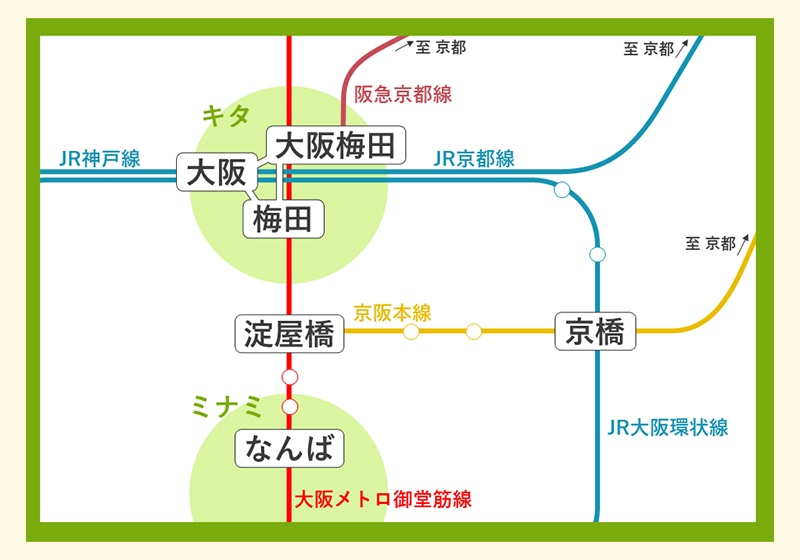
Hankyu’s Osaka Umeda Station is located right in the middle of Kita, Osaka’s main downtown district located in the North part of the city. It’s also known as Umeda and Osaka Station area. If you are in this part of town, definitely choose the Hankyu Railway to get to Kyoto. The Osaka Metro Sakaisuji Line also connects directly to Hankyu, so if you are starting from a station on this subway line, the Hankyu would be a good choice to get to Kyoto.
Keihan’s Yodoyabashi and Kyobashi Stations are near Kita too. So if these stations are more convenient for you, hope on the Keihan for an easy trip to Kyoto.
Keihan is convenient to get to Higashiyama. So is Hankyu!
[What is Kyoto’s Higashiyama area?]
Higashiyama is well-known from all its appearances on TV and in magazines. The most famous destination in Higashiyama is Kiyomizu-dera Temple, famous for its Kiyomizu-no-butai wooden stage and the roads that lead up to it—Ninenzaka and Sannenzaka. There are a number of other tourist attractions you’ll want to visit at least once, like the Yasaka Pagoda, which makes a gorgeous picture in the surrounding streetscape, and Yasaka Koshin-do, with its colorful hanging monkeys that really pop in photos.
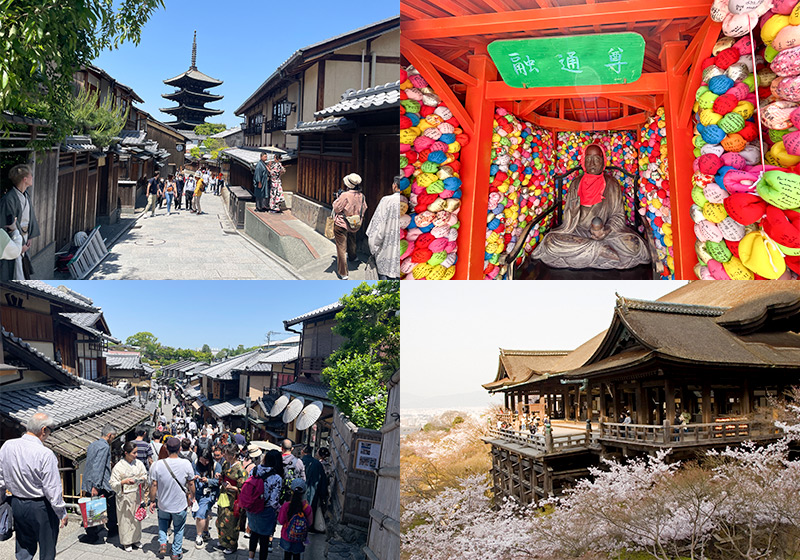
Major tourist spots in and around Higashiyama
Chion-in Temple / Yasaka-jinja Shrine / Maruyama Park / Kodai-ji Temple / Ninenzaka / Sannenzaka / Kiyomizu-dera Temple / Kennin-ji Temple / Yasui Konpiragū Shrine / Yasaka Pagoda (Hokan-ji Temple) etc.
Which train is the best way to get to Higashiyama?
Keihan ☆☆☆☆☆
Gion-Shijo Station is the nearest station to Higashiyama’s tourist spots. It’s the most convenient for visiting the many famous places in the area.
Hankyu ☆☆☆
Higashiyama is within walking distance of Kyoto-kawaramachi Station. So if you are coming from the Kita area of Osaka, (Osaka Station or Umeda) I recommend you take the Hankyu.
JR ☆
There is no JR station near Higashiyama, so you will need to use a bus or taxi to get there.
The best way to explore the Higashiyama area is to use the nearest Keihan or Hankyu station and stop at various places along the way to Higashiyama.
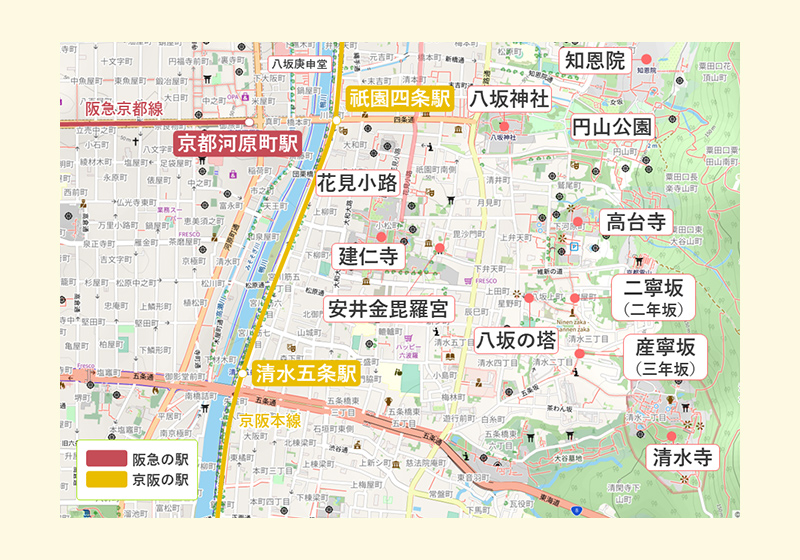
According to the Kiyomizu-dera Temple website, the leading tourist attraction in Higashiyama, the recommended way to get here is to take the Kyoto City Bus to the Gojozaka stop or the Keihan Bus to the Kiyomizu-michi stop. From there it says it’s a 10-minute walk. And while that may be the shortest walking distance to get to Kiyomizu-dera Temple, I think you’re missing out if you take this route. There are many attractions in the Higashiyama area, so it would be a waste to skip them!
If you have the time to spare, I’d recommend taking a stroll from Kyoto-kawaramachi Station or Gion-Shijo Station!
Take the Hankyu from Osaka to Arashiyama. It’s cheaper than JR!
[What is Kyoto’s Arashiyama Area?]
Arashiyama is located on the western side of Kyoto city. It’s an area full of seasonal charms, like the cherry blossoms in spring and colorful foliage in autumn.This scenic part of the city has been a beloved destination for people in the former capital city since the time of Emperor Kanmu. It’s full of famous places where Japanese people feel represent traditional Japan, such as Tenryu-ji Temple, Daikaku-ji Temple, Togetsu-kyo Bridge, and the famous bamboo forest path!

Major tourist spots in and around Arashiyama
Tenryuji Temple, Daikakuji Temple, Togetsukyo Bridge, Arashiyama Bamboo Grove, Sagano Scenic Railway, etc.
Which train is the best way to get to Arashiyama?
Hankyu ☆☆☆☆☆
It takes about 42 minutes to get to Arashiyama from Osaka Umeda Station. The fare is 410 yen so it’s a good value.
JR ☆☆☆
It takes about 45 minutes to get to Arashiyama from Osaka Station, and the fare is 990 yen. So it is more expensive than Hankyu.
Keihan ×
There is no Keihan station near Arashiyama, so I don’t recommended taking the Keihan to get to Arashiyama.
*The times listed above exclude time to transfer trains and are approximate times for the Hankyu limited express trains and JR special rapid trains.
JR is also a good option if you are heading to the Sagano Scenic Train and Toei Kyoto Studio Park, because the station is closer to both.

You can use either Hankyu or JR to get to the Arashiyama area.
If you take Hankyu, you need to transfer to the Hankyu Arashiyama Line at Katsura Station, which is on the Kyoto Line and runs between Osaka and Kyoto Station. If you opt for the JR, you need to transfer to the JR Sagano Line at Kyoto Station to get up to Arashiyama.
The travel time is almost the same no matter which railway you choose, but the fare is overwhelmingly cheaper if you take the Hankyu! JR’s Osaka Station and Hankyu’s Osaka-umeda Station are very close to each other so it doesn’t make much of a difference location-wise when you are getting on the train. But Hankyu’s Osaka-umeda Station is the first station for this line, so there’s a better chance that you can get a seat when you board the train. These are all reasons why I recommend the Hankyu Railway to get to Arashiyama!
On the other hand, it may make sense to take the JR depending on where you are going in Arashiyama. You can take the Sagano Scenic Railway from JR Saga-Arashiyama Station and this tourist train is a popular way to enjoy the scenery of the Hozugawa Valley. If you walked here from Hankyu’s Arashiyama Station it would take about 20 minutes. So if you are planning to ride this scenic train, it would be better to use the JR line.
Also, if you plan to stop by Toei Kyoto Studio Park, you can walk there from Uzumasa Station on the JR Sagano Line. In which case, you could take Hankyu on the way to Arashiyama and ride JR on the way back!
Keihan is a great way to get to Uji. But JR works too!
[What is Kyoto’s Uji area?]
Uji is a scenic city located south of downtown Kyoto, and is served by both JR and Keihan Electric Railways. It is a region where culture from the Heian period lives on and it was famously the setting for the Tale of Genji’s Uji Chapters. The picture-perfect Byodo-in Temple is also incredibly well-known, as it is the temple depicted on Japan’s 10 yen coin! There are other famous places in Uji as well, such as Ujigami Shrine, which is a registered World Heritage Site along with Byodo-in Temple. Plus Uji is a popular tourist area where you can enjoy gourmet food and the many matcha shops.

Major tourist spots in and around Uji
Byodo-in Temple / Uji Shrine / Ujigami Shrine / Uji River / Mimuroto-ji Temple / The Tale of Genji Museum, etc.
Which train is the best way to get to Uji?
Keihan ☆☆☆☆☆
It takes about 51 minutes to get to Uji from Yodoyabashi Station and it costs 430 yen. That’s less than half the price of JR, so it’s a good value.
JR ☆☆☆☆
The ride takes about 45 minutes from Osaka Station and costs 990 yen. It’s a bit expensive, but it’s convenient if you are departing from Osaka’s Kita area.
Hankyu ×
There is no Hankyu station in Uji, so it would not be a good option to get to Uji.
*The times listed above exclude time to transfer trains and are approximate times for JR’s special rapid service and Miyakoji rapid service, and Keihan’s limited express service.
You will need to transfer trains one time, whether you take JR or Keihan to get between Osaka and Uji.
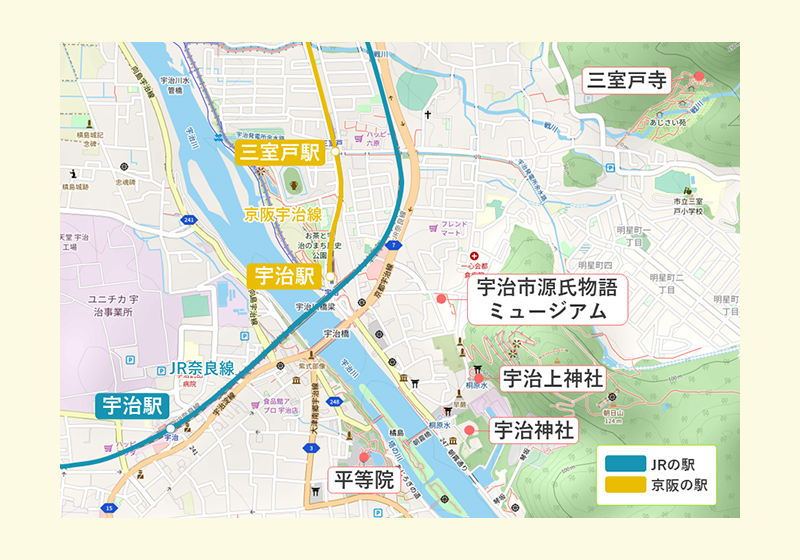
To go from Osaka to Uji, take the JR to Kyoto Station and then transfer to the Nara Line. Or take the Keihan line and transfer to the Keihan Uji Line at Chushojima Station. Whether you take JR or Keihan, you’ll have to make one transfer.
Once you have arrived in Uji, there is some distance between the JR and Keihan stations. But it takes about 10 minutes to walk to Byodoin Temple from both. However, if you are planning to visit other famous places in Uji, the Keihan line is going to be closer.
Train fare is 990 yen on the JR line and 430 yen on the Keihan line. So it is significantly cheaper to take the Keihan. To sum up, I recommend the Keihan line to travel between Osaka and Uji. However, and this is similar to what I wrote regarding Kawaramachi & Gion, if you are in the Kita part of Osaka, Umeda etc, it might be more troublesome to get to a Keihan station at the start, in which case it is a good idea to take the JR.

JR and Keihan Railway are in competing for passengers going to Fushimi Inari and Tofukuji Temple too!
On the way from Uji to Kyoto the JR and Keihan lines follow similar routes.
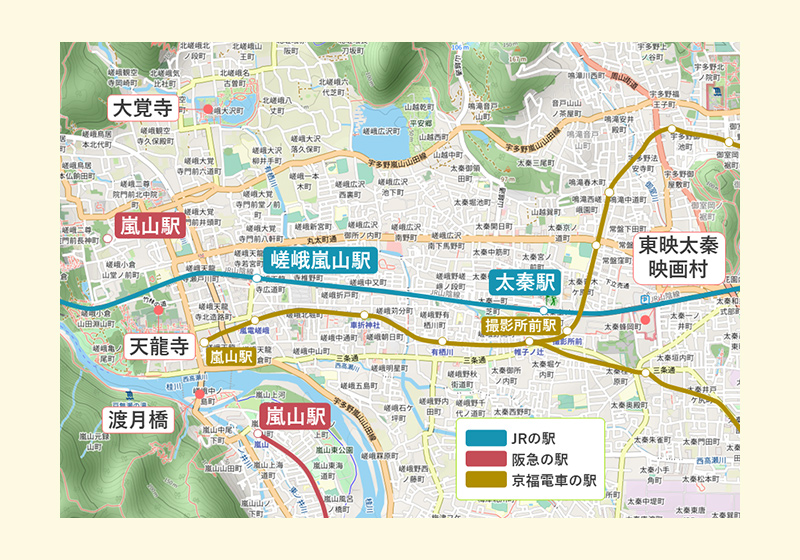
If you check a map, you can see that there are both JR and Keihan Electric Railway stations near Sennyuji Temple, Tofukuji Temple, Fushimi Inari Taisha Shrine, and Manpukuji Temple.
And if you compare the two, the results are essentially the same as what we found in the Uji area: Keihan Railway is cheaper and more cost-effective. However, some people may find JR to be faster and more convenient for places like Tofukuji Temple, which is near Kyoto Station.
Well, that’s as far as I can get today on the subject of trains.
When you are in Kansai, you’ll notice that while both Osaka and Kyoto are major cities in the Kansai region, each has its own unique atmosphere and traditions. When you are in Kansai, make time to visit both. And when you plan your train travel from Osaka to Kyoto, make sure you choose a route that is the most convenient and smooth.

Osaka Bob FAMILY
The contents of this page were current at the time it was posted, but may differ from the present.
Text visible in this map is based on information from Map Tiler and may differ from actual geographical names.


